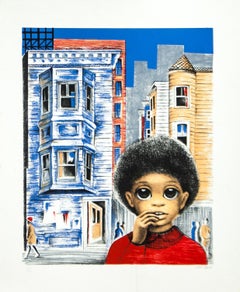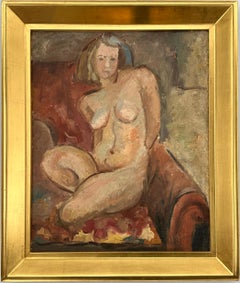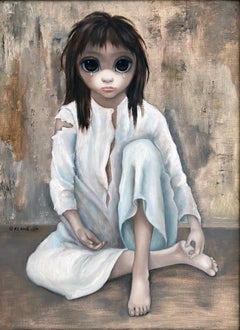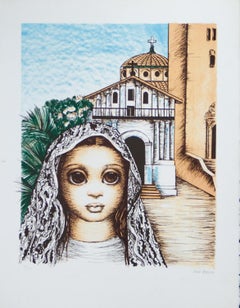Margaret Keane Art
Margaret Keane was born Peggy Doris Hawkins on September 15, 1927, in Nashville, Tennessee. When she was two years old, her eardrum was permanently damaged during a mastoid operation. Unable to hear properly, Keane learned to watch the eyes of the person talking to her to understand them.
Keane started drawing as a child. At age 10 she took classes at the Watkins Institute in Nashville. She created her first oil painting of two little girls — one crying and one laughing — when she was 10 years old and gave the work to her grandmother. Keane became well known at the local church for her sketches of angels with big eyes and floppy wings.
At age 18 Keane attended the Traphagen School of Design in New York City for a year. She initially earned money by painting clothing and baby cribs in the 1950s until she finally began painting portraits. Early on Keane experimented with kitsch. She worked in both acrylics and oil-based paints and limited the subjects of her artwork to women, children and familiar animals (cats, dogs and horses).
Keane's paintings are recognizable by the oversized doe-like eyes of her subjects. She said she was always interested in the eyes and used to draw them in her school books. She began painting her signature "Keane eyes" when she started to create portraits of children.
"Children do have big eyes,” Keane said. “When I'm doing a portrait, the eyes are the most expressive part of the face. And they just got bigger and bigger and bigger."
Keane focused on the eyes as they better illuminate the inner person. The artist cited Modigliani's work as a major influence on the way she had painted women since 1959. Other artists who influenced her use of color, dimension and composition include Van Gogh, Picasso and Klimt. She was named a Fellow of the Society of Western Artists after exhibiting in three Annual Juried Shows in the M.H. De Young Memorial Museum in San Francisco.
Keane's works are in collections all over the world. Public collections include the National Museum of Contemporary Art in Madrid, the National Museum of Western Art in Tokyo, the Tennessee Fine Arts Museum in Nashville and more.
Find original Margaret Keane paintings and prints on 1stDibs.
(Biography provided by Lucille Lucas Gallery)
1980s Expressionist Margaret Keane Art
Lithograph
Late 20th Century American Realist Margaret Keane Art
Screen
Mid-20th Century Modern Margaret Keane Art
Canvas, Oil
1970s American Realist Margaret Keane Art
Archival Paper, Lithograph
1930s American Modern Margaret Keane Art
Canvas, Oil
Late 20th Century Expressionist Margaret Keane Art
Lithograph
1980s American Realist Margaret Keane Art
Offset
1910s American Realist Margaret Keane Art
Lithograph
1940s American Realist Margaret Keane Art
Lithograph
Late 20th Century Expressionist Margaret Keane Art
Lithograph
Late 20th Century Expressionist Margaret Keane Art
Lithograph
1940s American Realist Margaret Keane Art
Etching
Late 20th Century Expressionist Margaret Keane Art
Lithograph
Mid-20th Century American Realist Margaret Keane Art
Lithograph
1920s American Realist Margaret Keane Art
Lithograph
1970s American Realist Margaret Keane Art
Canvas, Oil
1980s Expressionist Margaret Keane Art
Lithograph
1980s Expressionist Margaret Keane Art
Lithograph
1980s Expressionist Margaret Keane Art
Lithograph
Late 20th Century American Realist Margaret Keane Art
Lithograph
Late 20th Century American Realist Margaret Keane Art
Lithograph
Late 20th Century American Realist Margaret Keane Art
Lithograph
Margaret Keane art for sale on 1stDibs.
Artists Similar to Margaret Keane
- Was Keane a real artist?1 Answer1stDibs ExpertAugust 29, 2024Yes, Keane was a real artist. She was born Peggy Doris Hawkins on September 15, 1927, in Nashville, Tennessee. When she was two years old, her eardrum was permanently damaged during a mastoid operation. Unable to hear properly, Keane learned to watch the eyes of the person talking to her to understand them, and Keane's paintings are recognizable by the oversized doe-like eyes of her subjects. She began painting her signature "Keane eyes" when creating portraits of children. On 1stDibs, explore a variety of Margaret Keane art.
- 1stDibs ExpertAugust 26, 2024The real artist of Big Eyes is Margaret Keane. Keane's paintings are recognizable by the oversized, doe-like eyes of her subjects. She said she was always interested in eyes and used to draw them in her school books. She began painting her signature "Keane eyes" when she started to create portraits of children. "Children do have big eyes,” Keane said. “When I'm doing a portrait, the eyes are the most expressive part of the face. And they just got bigger and bigger and bigger." On 1stDibs, find a range of Margaret Keane art.
- Is Keane a real artist?1 Answer1stDibs ExpertOctober 15, 2024Yes, Keane is a real artist. Margaret Keane was born Peggy Doris Hawkins in Nashville, Tennessee, on September 15, 1927. At age 18, Keane attended the Traphagen School of Design in New York City for a year. Early on, Keane experimented with kitsch. She began painting her signature oversized "Keane eyes" when creating portraits of children. She said she was always interested in the eyes and used to draw them in her school books. Her life inspired the 2014 film Big Eyes. Find a selection of Margaret Keane art on 1stDibs.
- 1stDibs ExpertOctober 24, 2024How much the Tomorrow Forever painting is worth is unknown, as there are no recent publicly available sales records for the work. However, Margaret Keane's paintings have often sold for tens of thousands of dollars. For example, her Portrait of Zsa Zsa Gabor fetched a price of $45,000 at auction in 2018. Generally, Keane is known for painting her subjects with oversized doe-like eyes. She began painting her signature "Keane eyes" when she started to create portraits of children. Shop a range of Margaret Keane art on 1stDibs.
- 1stDibs ExpertOctober 15, 2024The real story behind Big Eyes is the life of artist Margaret Keane. She was born Peggy Doris Hawkins on September 15, 1927, in Nashville, Tennessee. When she was two years old, her eardrum was permanently damaged during a mastoid operation. Keane learned to watch the eyes of the person talking to her to understand them, influencing the drawings he began creating as a child. At age 10, she took classes at the Watkins Institute in Nashville. At age 18, she attended the Traphagen School of Design in New York City for a year. She initially earned money by painting clothing and baby cribs in the 1950s until she began painting portraits. Early on, Keane experimented with kitsch. She began painting her signature "Keane eyes" when she started to create portraits of children. Keane's works are now in collections all over the world, including the Museum of Contemporary Art in Madrid, the National Museum of Western Art in Tokyo and the Memphis Brooks Museum in Memphis, Tennessee. On 1stDibs, shop a diverse assortment of Margaret Keane art.
- Are Big Eyes paintings real?1 Answer1stDibs ExpertOctober 15, 2024Yes, Big Eyes paintings are real. They are the work of artist Margaret Keane, whose life inspired the 2014 film Big Eyes. Her paintings are recognizable by the oversized, doe-like eyes of her subjects. She said she was always interested in the eyes and used to draw them in her school books. She began painting her signature "Keane eyes" when she started creating portraits of children. On 1stDibs, find a collection of Margaret Keane art.




